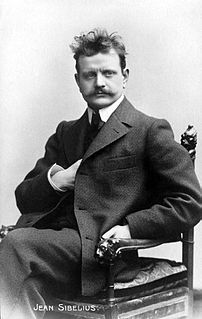
Jean Sibelius was a Finnish composer of the late Romantic and early-modern periods. He is widely regarded as his country's greatest composer, and his music is often credited with having helped Finland develop a national identity during its struggle for independence from Russia.

Einojuhani Rautavaara was a Finnish composer of classical music. Among the most notable Finnish composers since Jean Sibelius (1865–1957), Rautavaara wrote a great number of works spanning various styles. These include eight symphonies, nine operas and twelve concertos, as well as numerous vocal and chamber works. Having written early works using 12-tone serial techniques, his later music may be described as neo-romantic and mystical. His major works include his first piano concerto (1969), Cantus Arcticus (1972) and his seventh symphony, Angel of Light (1994).
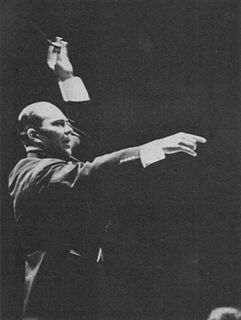
Paavo Allan Engelbert Berglund was a Finnish conductor and violinist.

The Sibelius Academy is part of the University of the Arts Helsinki and a university-level music school which operates in Helsinki and Kuopio, Finland. It also has an adult education centre in Järvenpää and a training centre in Seinäjoki. The Academy is the only music university in Finland. It is among the biggest European music universities with roughly 1,400 enrolled students.

Leif Selim Segerstam is a Finnish conductor, composer, violinist, violist and pianist, especially known for writing 350 symphonies as of August 2022, along with other works in his extensive oeuvre.
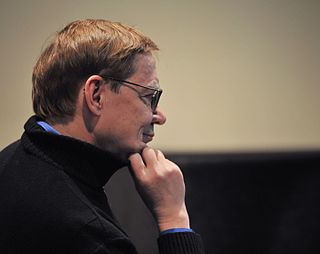
Kalevi Ensio Aho is a Finnish composer.
Atso Almila is a Finnish orchestral conductor, music director, composer, trombonist and teacher.

Joonas Kokkonen was a Finnish composer. He was one of the most internationally famous Finnish composers of the 20th century after Sibelius; his opera The Last Temptations has received over 500 performances worldwide, and is considered by many to be Finland's most distinguished national opera.
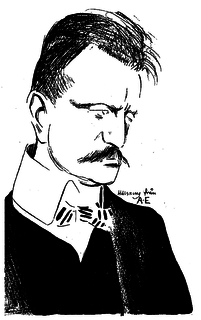
The Symphony No. 2 in D major, Op. 43, by Jean Sibelius was started in winter 1901 in Rapallo, Italy, shortly after the successful premiere of the popular Finlandia, and finished in 1902 in Finland. Sibelius said, "My second symphony is a confession of the soul."

Mikko Franck is a Finnish conductor and violinist.
Sinfonia da Requiem, Op. 20, for orchestra is a symphony written by Benjamin Britten in 1940 at the age of 26. It was one of several works commissioned from different composers by the Japanese government to mark Emperor Jimmu's 2600th anniversary of the founding of the Japanese Empire. The Japanese government rejected the Sinfonia for its use of Latin titles from the Catholic Requiem for its three movements and for its somber overall character, but it was received positively at its world premiere in New York on 29 March 1941 under John Barbirolli. A performance in Boston under Serge Koussevitzky led to the commission of the opera Peter Grimes from the Koussevitzky Music Foundations.

Jorma Kalervo Hynninen is a Finnish baritone who performs regularly with the world's major opera companies. He has also worked in opera administration.

Ondine is a Finnish classical record label founded in 1985 in Helsinki, Finland. Its catalogue with several award-winning releases includes over 600 titles with major Finnish and international artists.
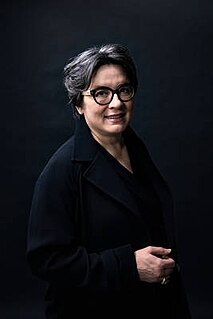
Lilli Katriina Paasikivi-Ilves is the artistic director of the Finnish National Opera since 2013 and a mezzo-soprano.
Incantations for Percussion and Orchestra is a concerto for percussion and orchestra in three movements by the Finnish composer Einojuhani Rautavaara. The work was composed for the percussionist Colin Currie on a joint commission from the London Philharmonic Orchestra, the Baltimore Symphony Orchestra, the Rotterdam Philharmonic Orchestra, and the Tampere Philharmonic Orchestra. The first performance was given in Royal Festival Hall, London by Currie and the London Philharmonic Orchestra under the conductor Yannick Nézet-Séguin on October 24, 2009.
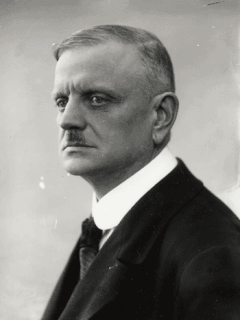
My Own Land, Op. 92, is a single-movement cantata for mixed choir and orchestra written in 1918 by the Finnish composer Jean Sibelius. The piece, which is a setting of Kallio's Finnish language poem of the same name, is the first in a series of four "little known but beautiful", patriotic cantatas from the composer's mature period—including Song of the Earth ; Hymn of the Earth ; and Väinämöinen’s Song. My Own Land premiered on 25 October 1918 in Helsinki with Armas Maasalo conducting the Helsinki Youth League —the commissioning ensemble and dedicatee—and the Helsinki Philharmonic Orchestra.

The Symphony No. 1 in F major, Op. 29, is a three-movement orchestral composition by the Finnish composer Leevi Madetoja, who wrote the piece from 1914–16 at the dawn of his professional career. Although late-Romantic in style, the symphony carefully eschews the extravagance and overindulgence typical of debut efforts, placing it among the most "mature" and restrained of first symphonies. Accordingly, the First is the shortest and most concentrated of Madetoja's three essays in the form and is the only one of his symphonies not to adhere to the traditional four-movement symphonic template.
Towards the Horizon is the second cello concerto by the Finnish composer Einojuhani Rautavaara. The work was commissioned by the Minnesota Orchestra under the direction of Osmo Vänskä. It was first performed by the cellist Arek Tesarczyk and the Minnesota Orchestra conducted by Osmo Vänskä in Orchestra Hall, Minneapolis, on September 30, 2010. The piece is dedicated to the cellist Truls Mørk, who was originally scheduled to perform the world premiere, but had to drop due to health concerns.

Einojuhani Rautavaara wrote his Piano Concerto No. 1, Op. 45, in 1969.















